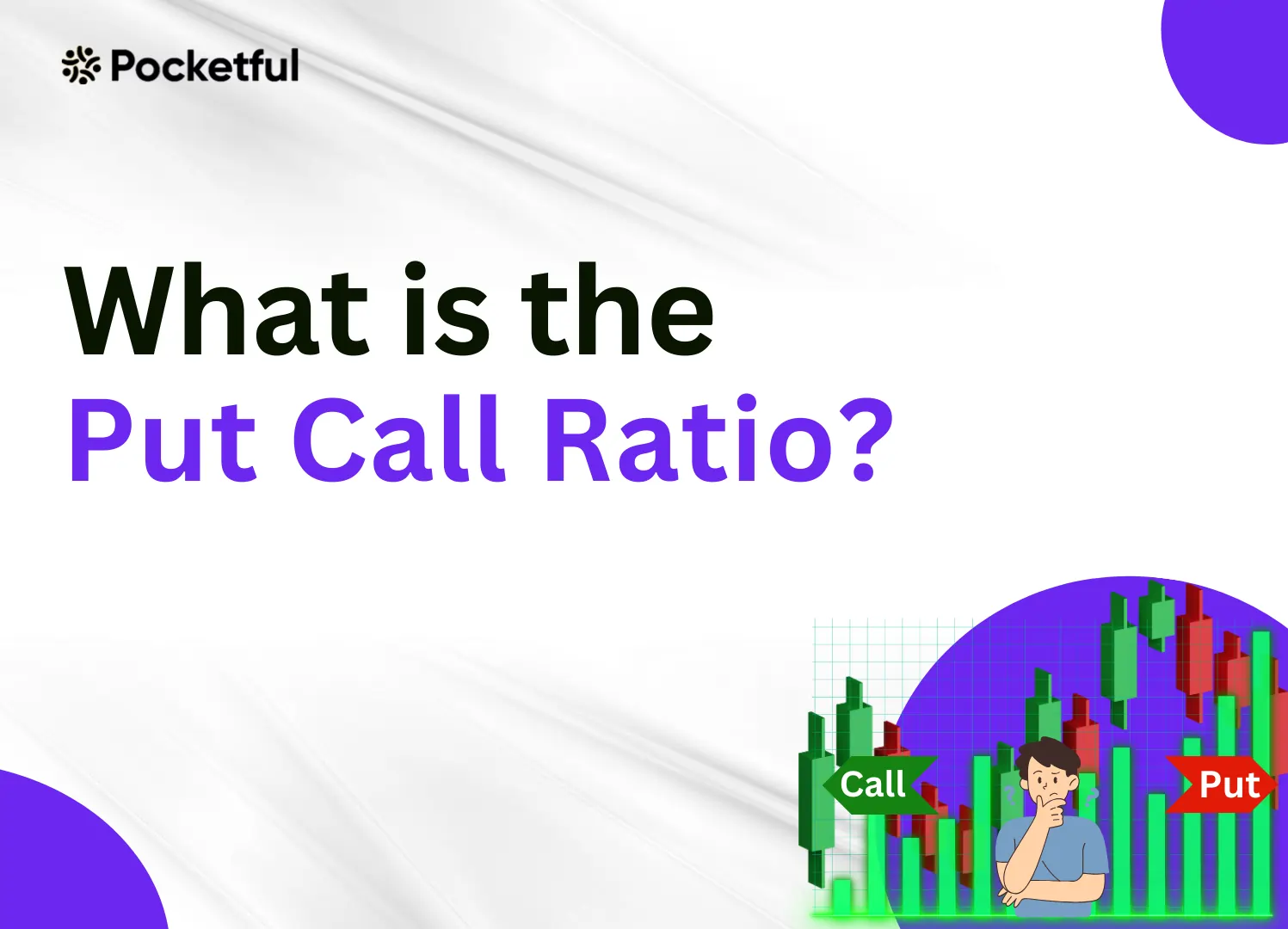| Type | Description | Contributor | Date |
|---|---|---|---|
| Post created | Pocketful Team | Jun-24-24 | |
| Add new links | Nisha | Mar-18-25 |
What is Put-Call Ratio?

Are you confused about the market sentiment? Want to increase the probability of success in identifying market trends? Learn about the Put Call ratio and begin your journey toward being a profitable trader. So, let’s dive in.
Definition of the Put Call Ratio
A Put Call Ratio is a derivative indicator and is also known as PCR. It effectively determines the bullish or bearish sentiments in the market using the options data. This ratio is computed either by using the open interest data for that particular stock or indices for a given period of time or based on the volume data of options trading.
Formula of Put Call Ratio (PCR)

The Put Call Ratio (PCR) is a derivative indicator used in the stock market to gauge investor sentiment about the future direction of a stock or Indices. It’s calculated by dividing the number of traded put options by the number of traded call options over a specific period of time. The PCR can be calculated in two ways:
- Based on open interests: PCR (OI) = Put (Open Interest)/( Call Open Interest)
- Based on the volume: PCR (Volume) = (Put Trading Volume)/(Call Trading Volume)
A high PCR indicates bearish sentiment, and a low PCR indicates bullish sentiment.
For example, if the total number of puts traded is 1500 and the total number of call options traded is 1000, then the PCR ratio is 1500/1000. A PCR above 1 indicates that the put volume has exceeded the call volume, which indicates bearish sentiment in the market.
Interpretation of the Put Call Ratio (PCR)
- PCR = 1 is considered balanced
- PCR >1 is considered bearish
- PCR = 0.70 is considered Neutral
- PCR approaching above 0.70 is also considered bearish
- PCR falling below 0.70 and approaching 0.50 is considered bullish.
- Extremely low PCR (e.g., 0.5 or 0.3) = very bullish
- Extremely high PCR (e.g., 1.5 – 2.0) = Very bearish
Put Call Ratio (A Contrarian Indicator)
Traders generally use the Put Call Ratio (PCR) as a contrarian indicator when the values go extremely high. A high Put Call ratio, say 1.5, is considered a great buying opportunity because they believe that the market sentiment is extremely bearish and will soon adjust. In India, Nifty’s PCR ratio follows a trend and oscillates between 0.8 to 1.3.
Combining PCR with Implied Volatility (IV)
We can also use Implied Volatility along with PCR for more insight. It is an excellent way of interpreting market sentiment. Implied Volatility is the expected price changes in a security’s price over a period of time, and it reflects the risk perception in the market.
If the PCR increases with an increase in IV, then it indicates that the put activity is increasing and risk is also rising. It is a bearish signal.
If the PCR increases with a decrease in IV, it indicates that put activity is increasing with falling risk levels. It indicates more writing of puts, which is a bullish signal.
If the PCR decreases with a decrease in IV, it indicates the unwinding of Puts and can be interpreted as a signal that markets may be bottoming out.
If the PCR decreases with an increase in IV, it means that puts are being covered, and the markets will fall again after short covering.
Uses of Put Call Ratio

The uses of PCR are given below –
- It is an efficient tool that helps determine the market sentiment of a particular stock or the overall market.
- PCR is helpful in analyzing the overall trading behavior of the market participants.
- PCR can be combined with other option data to make trading decisions.
- It is a contrarian indicator that helps traders escape the herd mentality and think contrary to the current mass view of the market.
Read Also: Ratio Analysis: List Of All Types Of Ratio Analysis
Example of Put Call Ratio

For example, a Nifty trader plans to use PCR to gauge market sentiments. The puts and calls initiated are as follows –
For example, a Nifty trader plans to use PCR to gauge market sentiments. The puts and calls initiated are as follows –
Type of Option and their respective number of contracts:
Puts initiated = 128000
Calls initiated = 167450
PCR = Total put open interest/ Total call open interest
= 128000/167450
= 0.7644
As per put-call ratio analysis, this indicates normal to slightly bearish market sentiment.
Limitations of PCR
- One of the most significant flaws of PCR is that it does not always represent the market sentiments, as it can also be a contrarian indication.
- Many stocks aren’t active in the options segment, making it impossible to compute the PCR for such stocks.
- PCR is meaningful when the contract is liquid for an extended period of time. Calculating PCR based on sudden jumps in volumes can be misleading and lead to wrong decisions.
- There is no specific value that indicates that the market has created a bottom or a top, but traders generally analyze this by looking for extreme values.
- Investors must also use other indicators and data before betting on market sentiments and direction.
- Investors must know how to read the PCR chart correctly; a slight misunderstanding will defeat the entire purpose of the analysis.
Read Also: Explainer on Liquidity Ratios: Types, Importance, and Formulas
Conclusion
It’s a derivative tool to gauge market sentiment. It is a contrarian indicator and uses derivative data like call and put open interest or their volumes to get market direction. This derivative indicator has its share of drawbacks as well. Investors must understand its limitations in detail to use it properly. The PCR should be analyzed over different time frames, such as daily, weekly, or monthly. It is also essential to consider the PCR with other technical and fundamental analysis tools for a more comprehensive view of market conditions.
Frequently Asked Questions (FAQs)
What is the Put Call Ratio?
It is used as an indicator to gauge overall bullish or bearish market sentiments.
Is PCR a good study?
Yes, it’s a reasonable basis for evaluating sentiments.
If PCR is more than 1, what does it indicate?
When PCR is greater than 1, it suggests that there are more open put contracts than call contracts, indicating a bearish sentiment.
How to read PCR?
PCR = 1 is considered balancedPCR >1 is considered bearishPCR <1 is considered bullish
Is PCR suitable for beginners?
PCR is used in option analysis, which is unsuitable for beginners as it is extremely risky.
Disclaimer
The securities, funds, and strategies discussed in this blog are provided for informational purposes only. They do not represent endorsements or recommendations. Investors should conduct their own research and seek professional advice before making any investment decisions.